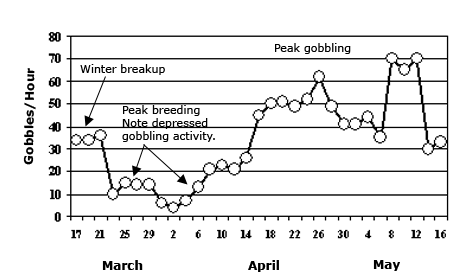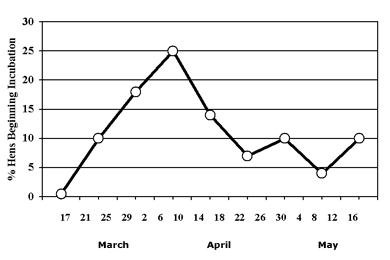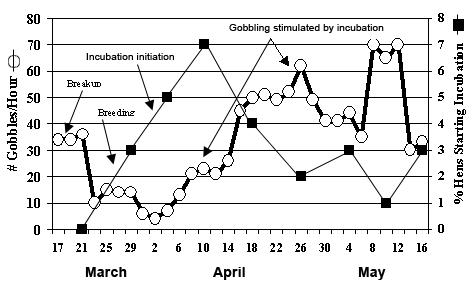Wildlife - Wild Turkeys
Setting Spring Hunting Seasons by
Timing Peak Gobbling, Peak Breeding and Peak Incubation
Introduction
In 1970, the South Carolina Wildlife and Marine Resources Department (SCWMRD) developed a Wild Turkey Research Project and the "Turkey Project" remains today as one of several special program areas in the Wildlife Section of the South Carolina Department of Natural Resources (SCDNR). The original objectives of the Turkey Project were to develop census techniques to monitor rapidly expanding turkey populations in the piedmont and to ascertain distribution patterns relative to habitat management practices. Studies also were initiated to determine peak periods of gobbling and nest incubation in order to best determine when the spring season should begin and end. Spring seasons were open only in areas of the state with adequate numbers of turkeys. Much of the state, particularly in the coastal plain, had no open season because there were few or no turkeys. In 1975, a comprehensive biological plan was developed by the Department for the restoration of turkeys in the coastal plain. This restoration plan was implemented between 1976 and 2003, resulting in the capture and translocation of approximately 3,542 turkeys on 204 restoration sites statewide. In 1993 a portion of all counties were open to spring gobbler hunting and in 1998 all counties were fully opened with the exception of recent restoration sites.
Wild turkey seasons in South Carolina are established under authority of SC Code of Laws Sections 50-11-520 and 50-11-560. Prior to 1976, all spring gobbler seasons in South Carolina began on March 15 and ended on April 15. Results of gobbling and nesting studies conducted in the piedmont and coastal plain during the 1970s led to changes in the spring turkey season dates. Based on results from these studies, the Department recommended a statewide season of April 1-May 1 that offers the following benefits over the old March 15-April 15 season: better weather conditions, less disruption in breeding activity, a reduction in inadvertent or illegal hen kill, and the ability to hunt during the longest and most consistent peak in statewide gobbling so that gobblers will have increased responsiveness to hunters' calls.
Since 1976, seasons in Game Zones 1, 2, 3, 4, and 5 are as recommended by SCDNR, April 1-May 1 (SC Code 50-11-520). Conversely, the General Assembly provided no authority for SCDNR to set seasons in Game Zones 6 (lower coastal plain) and in 1976 opted to take the Department's recommendation for the new biologically established season and add it to the old socio-political season (SC Code 50-11-560). This resulted in a March 15-May 1 season in the twelve counties that makes up Game Zone 6.
With respect to both biology and effective hunting, the timing of spring gobbler seasons in South Carolina should take into account three primary factors; peak breeding, peak gobbling, and peak incubation. Considering these factors, seasons can be set to afford hunters the best opportunity to hunt during the best time (i.e. peak gobbling period) without inhibiting reproductive success.
The following describes how the current April 1-May 1 season was developed in South Carolina.
Peak Gobbling
Gobbling by male wild turkeys occurs primarily in the spring and for the purpose of attracting hens for mating purposes. Although there is typically some gobbling in mid March in South Carolina, this is not "the peak" in gobbling that hunters should be interested in. This gobbling is associated with the breakup of winter turkey flocks (Figure 1). Gobbling associated with winter break-up is not as consistent or long in duration as the true peak in gobbling that occurs about one month later. Gobbling during mid March is primarily by subdominant males attempting to come away from the winter flocks with hens. Inevitably, dominant gobblers will come away from the winter flocks with most of the hens in a harem type arrangement. By about the third week in March the winter flock breakup is well underway and this initial minor peak in gobbling ceases. Most breeding occurs immediately following flock breakup and there is a period of nearly 2 weeks during which there is very little gobbling (Figure 1). Hunting during this period can be frustrating because as hunters say, "they are all henned up".
By the first week in April the nesting phase of the wild turkey breeding period is underway. During this time hens will lay one egg per day until the clutch is complete. In South Carolina most of the laying is done in about two weeks, therefore, most hens begin incubation during the first half of April. When the majority of hens begin incubation gobbling begins in earnest. Remember, male turkeys gobble to attract hens. During peak breeding hens are available, therefore, little gobbling takes place. Once hens begin spending increasing amounts of time away from the gobblers (extended stays at the nest and ultimately continuous incubation) the longest and most consistent peak in gobbling occurs (Figure 1). This time frame offers the best opportunity to hunt gobbling birds.
Figure 1. Gobbles heard per hour from an unhunted area in the piedmont of South Carolina (adapted from Bevill 1975). The longest and most consistent gobbling occurs from April 16-28. Data from the lower coastal plain is similar with peak gobbling about one week earlier (April 6-22).

Peak Breeding
Intensive research on Eastern wild turkeys has shown that timing of breeding can be predicted by latitude alone (Whitaker et al., 2004) and breeding is relatively consistent from year to year. Photoperiod or length of day is likely highly involved in this latitudinal predictability and consistency in breeding. In South Carolina peak breeding commences following the winter breakup that takes place in mid to late March. Hunters often complain that spring gobbler season begins too late. However, for several biological reasons, seasons should not begin before the peak of breeding.
First, the effects of removing dominant gobblers prior to breeding are obvious. If too few dominant gobblers are left to breed hens it could impact reproduction (unfertilized eggs) leading to a decrease in turkey numbers. Also, removing dominant males leaves mostly subdominant gobblers to breed, which may have negative consequences over time.
Second, gobbling activity is poor during peak breeding. It is a fact that male turkeys gobble primarily to attract hens. During peak breeding, hens are readily available because they have remained with gobblers immediately following the winter flock breakup, therefore, there is little gobbling activity during peak breeding (Figure 1). As previously mentioned, hunting during this period can be frustrating due to the abundance of hens and little gobbling.
Finally, numerous studies have shown that hens can be very susceptible to inadvertent or illegal kill prior to peak incubation.
Peak Incubation
Not only is it important for spring gobbler seasons to begin following the peak of breeding, it is also important for seasons to coincide with the peak in incubation. Peak incubation is defined as the period during which the majority of hens are on nests. In South Carolina, peak breeding in wild turkeys occurs the last couple of weeks in March and the first week in April. Allowing about 2 weeks for fertilization and egg laying means that the peak dates for beginning incubation are April 1-15 (Figure 2). The reason it is important for seasons to coincide with the peak of incubation is to minimize inadvertent or illegal harvest of hens.
Remember, during peak breeding hens spend a considerable amount of time with gobblers and often respond to hunters’ calls along with the gobbler. Repeated studies have shown that inadvertent or illegal harvest of hens is a significant mortality factor in the spring. Ask any spring turkey guide or experienced hunter who frequently takes other hunters and they will tell you that care must be taken to avoid inadvertently killing hens, particularly when hens are with gobbling toms. On the other hand, once incubation begins hens are isolated and spend all but a few minutes each day on the nest. The bottom line is that hens are less susceptible to inadvertent/illegal kill during the egg laying period and least susceptible during incubation. Finally, peak gobbling is stimulated by the fact that hens are no longer present since they are incubating.
Figure 2. Timing of the start of incubation for hens in the piedmont (adapted from Bevill 1975). Peak incubation occurs the first two weeks in April. Data for lower coastal plain is similar with peak incubation about one week earlier.

Putting It All Together
Setting spring turkey seasons is a balance between providing hunters with an opportunity to hunt and kill adult toms during peak gobbling without sacrificing the breeding success of hens. Some hunters are confused by the fact that the season begins after the first “minor” peak in gobbling in mid March, however, this first peak is related to the break-up of winter flocks and is not the true peak in spring gobbling. Following this minor peak in gobbling is peak breeding. This period, during late March, offers poor hunting opportunity because hens are with gobblers, therefore, gobbling activity is sparse and inconsistent, i.e. they are henned up. Also, since hens are spending considerable time with gobblers they are vulnerable to inadvertent or illegal harvest, an issue that has repeatedly been documented through studies.
Biologically, the optimal time for spring gobbler season occurs once hens begin to lay eggs and incubate. Gobblers can be killed since they are no longer needed for breeding. Hens are “out of the picture” making them less vulnerable to inadvertent or illegal kill and their absence also stimulates the longest and most consistent peak in gobbling (Figure 3). Finally, although the tendency in an unhunted area is for peak gobbling to last nearly a month, hunters should remember that hunting pressure effects gobbling activity. Today, with nearly 50,000 turkey hunters in the state, there should be no question that hunting pressure during the first 10 days to two weeks of the season impacts gobbling. Responsive gobblers are killed and survivors become “buggered-up”. Therefore, hunters should manage their expectations related to the duration of strong gobbling activity. All things considered, April 1 is the ideal date for the spring gobbler season to open in South Carolina. This date affords hunters the opportunity to hunt during the natural peak of gobbling without sacrificing the reproductive success of hens. However, the 12 counties that comprise Game Zone 6 have a long tradition of a March 15 turkey season opening and there is no proposal for change to the opening date. In fact, the Board of the DNR is on record in support of the current wild turkey season frameworks in South Carolina.
Figure 3. Comparison of peak gobbling and beginning dates for incubation by hens in the piedmont of South Carolina. Peak gobbling is a direct result of the lack of hens due to nesting activities. Data for lower coastal plain is similar with peak dates about one week earlier (adapted from Bevill 1975).

Points to remember concerning April 1-May 1 spring gobbler season
- Prior to 1976 all spring gobbler seasons in South Carolina were March 15-April 15. Keep in mind that many areas of the state had no turkey season at that time.
- Between 1972 and 1974, intensive studies were undertaken to determine peak periods for gobbling in both the piedmont and coastal plain. Studies of nest initiation by hens were also conducted using radio-telemetry. These were multi-year studies with data being combined to generate peak gobbling/incubation, therefore, any annual effects of weather should be negligible.
- These studies were conducted on both hunted and unhunted sites. However, due to sporadic gobbling patterns on all hunted areas monitored, only data collected on unhunted sites were used in determining peaks of gobbling. Most hunters are aware of the negative relationship between hunting pressure and gobbling activity and problems in using gobbling data from hunted areas had previously been noted in studies from other states, as well.
- The first peak in gobbling in the piedmont occurs during the period March 17-21 (5-7 days earlier in the lower coastal plain). Gobbling during this period can be attributed to winter flock breakup and attempts by subdominant males to win harems of hens.
- Following this initial peak, depressed gobbling activity occurs over a 10 day to two week period during late March and early April. This depressed gobbling activity can be attributed to the abundance of hens accompanying dominant gobblers.
- It is important to note that although gobbling is depressed during this period, breeding takes place with dominant gobblers breeding hens that have remained with them following breakup.
- Breeding is controlled by photoperiod (day length) and is predictable based on latitude.
- Hunting can be frustrating during peak breeding because hens are with adult males, i.e. gobblers are "henned up".
- Hens are vulnerable to inadvertent or illegal harvest during peak breeding since they spend considerable time with gobblers that respond to hunters' calls.
- Inadvertent/illegal kill of hens has been documented by numerous studies to be a significant mortality factor associated with spring seasons that are set too early.
- Nest initiation/incubation begins the first week in April with peak dates for the beginning of incubation April 1-15.
- As a result of nest incubation, hens are no longer with gobblers and are less likely to be exposed to inadvertent or illegal harvest.
- As a result of nest initiation/incubation, gobbling begins in earnest due to lack of available hens.
- It is important to note that once bred, a hen remains fertile for an extended time period, so killing gobblers after fertilization is not too critical. On the other hand, killing too many gobblers prior to fertilization can result in unfertilized eggs being laid/incubated.
- During the period April 8-May 16 (April 1-May 9 in lower coastal plain) gobbling becomes more active with the longest interval of consistent gobbling occurring from April 16-28 (April 6-22 in lower coastal plain).
- Hunters should not expect consistent gobbling during the entire "peak of gobbling" in hunted areas due to the effects of hunting pressure. Responsive birds are killed immediately and survivors may become "buggered-up". In reality, about 10 days of good gobbling can be expected except in very lightly hunted situations.
- Following these studies DNR recommended an April 1-May 1 season statewide.
- DNR historically had authority to set seasons in what is now Game Zones 1, 2, 3, 4, and 5. Based on the biological data, the new April 1-May 1 season was adapted in 1976. The April 1-May 1 season was set in statute in 2006.
- DNR never had authority to set seasons in Game Zones 6. In 1976 the General Assembly chose to add the biologically recommended season to the socio-politically set "historic" season resulting in the longer, early opening March 15-May 1 season in the lower coastal plain.
- If the season is set correctly, the greatest proportion of gobblers should be harvested during the first week of the season because a high percentage of hens are nesting resulting in "lonely" gobblers that are responsive to hunter'Ss calls.
- Harvest by week of season demonstrates that the April 1 framework offers better hunting because 43 percent of gobblers are taken during the first week compared to 27 percent during the first week of the March 15 framework.
Literature Cited
Beville, W. V., Jr. 1975. Setting spring gobbler hunting seasons by timing peak gobbling. Proc.
National Wild Turkey Symp. 3:198-204.
Whitaker, D. M., J. C. Pack, G. W. Norman, D. F Stauffer, and S. Klopfer. 2005. A rang-wide meta-analysis of wild turkey breeding phenology. In press. In C. A. Stewart, ed., Proceedings of the Ninth National Wild Turkey Symposium, Michigan Department of Natural Resources, Lansing, MI. Report to the Northeast Wild Turkey Technical Committee 42p.
The information above "Setting Spring Hunting Seasons by Timing Peak Gobbling, Peak Breeding, and Peak Nesting" is provided in the Adobe® Acrobat® (PDF) format. Adobe® Reader® is required to open this file and is available as a free download from the Adobe® Web site.

